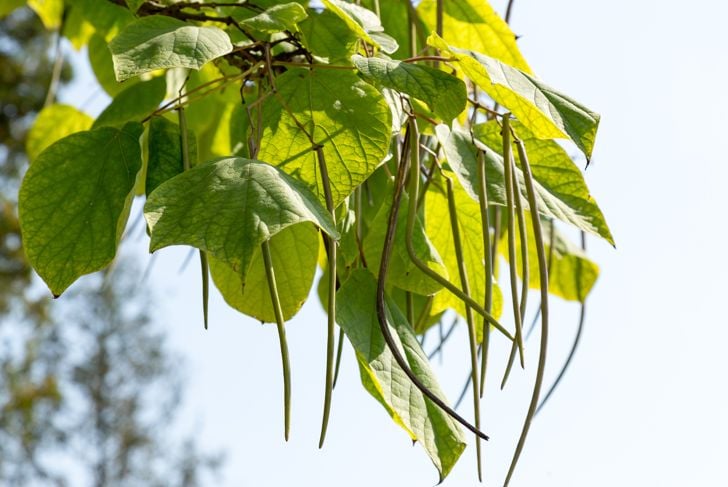The catalpa tree produces long slender seed pods that dangle like beans from its branches in midsummer. These distinctive pods inspire its alternate common name the cigar tree. But can you actually eat catalpa pods? Let’s explore the edibility and uses of this unusual tree fruit.
What Are Catalpa Pods?
The catalpa or catawba tree bears fruit that resemble a string of giant green beans. Here are some key facts about catalpa pods:
-
Form on the tree in late spring after flowering.
-
Mature to a brown color and dry out while hanging on the tree.
-
Range from 4-18 inches long and 1⁄2 inch wide.
-
Contain numerous seeds embedded in a papery pulp
-
Often persist on bare branches through winter.
-
Eventually split open to release oval winged seeds.
There are several catalpa species, but the common and southern catalpa are most prevalent. They produce similar long seed pods in abundance.
Are Catalpa Pods Edible?
Catalpa pods are not generally considered edible. Here’s what you need to know about the edibility factor:
-
The taste is bland and the texture is tough when raw.
-
The seeds and pulp provide no substantial nutritional value.
-
Eating the pods provides no known health benefits or risks.
-
Green pods contain a bitter, milky juice that may cause stomach upset.
-
Some people do sample the pods out of curiosity without ill effects.
-
The pods are fibrous and unsuitable for culinary purposes.
Traditional Medicinal Uses of Catalpa
Various parts of the catalpa tree have been used traditionally for medicinal purposes:
-
Native Americans used poultices of leaves to treat wounds and swollen joints.
-
The roots were brewed into teas to treat malaria, irregular menstruation, and postpartum pain.
-
Crushed seeds served as a vermifuge to expel intestinal worms.
-
Smoke from burning pods was inhaled to relieve asthma symptoms.
However, these folk remedies have not been substantiated by scientific research. There are no current medical applications for catalpa plant parts.
Unique Uses for Catalpa Pods
While not a viable food source, catalpa pods do offer some unique uses:
-
Handsome addition to dried flower arrangements and craft projects.
-
Hollowed-out pods make novel candle holders.
-
Dried pods burned with wood produce vibrant blue flames.
-
Striking appearances for floral centerpieces and wreaths.
-
Whimsical garlands to adorn mantels and stair railings.
-
Natural texture and color for potpourri mixes.
-
Statement accessories when spray painted and incorporated into jewelry or decor.
-
Distinctive savory smoker chips impart a unique flavor.
-
Versatile material for creating birdhouses, vases, planters and other wood crafts when dried and carved.
The buoyancy and cavity of unopened green pods allows them to serve as impromptu boats for children’s water play. Overall, catalpa pods lend themselves well to arts, crafts and playtime fun rather than food.
Potential Side Effects of Ingesting Catalpa Parts
While catalpa fruits are not considered highly toxic, ingesting certain parts may cause some stomach upset or other side effects:
-
Nausea, vomiting, or diarrhea from pods which contain saponins and alkaloids.
-
Contact dermatitis or rash from skin exposure to leaf or pod juices in sensitive individuals.
-
Choking hazard presented by small seeds if pods are swallowed.
-
Possible allergic reaction in those with plant sensitivities.
In general, sampling a few pods out of curiosity will not harm most people. However, it’s inadvisable to ingest large quantities of any catalpa plant parts.
How to Harvest and Dry Catalpa Pods
Follow these tips for collecting catalpa pods:
-
Wait until pods turn brown on the tree to fully mature.
-
Use pruning shears or long pole cutters to snip off branches with abundant pods.
-
Spread pods on a mesh screen or burlap in a warm, dry, airy location out of direct sun.
-
Allow pods to dry for 1-3 weeks until completely brittle.
-
Shake dried pods over a container to separate seeds for planting.
-
Spray with clear acrylic sealer if using for crafts or decor.
-
Store dried pods in sealed containers to use as needed.
Catalpa seeds need exposure to cold, damp conditions for several months before they will germinate. If planting seeds harvested from pods, sow outdoors right after collection or pre-chill seeds in your refrigerator over winter.
A Unique Tree with Intriguing Fruit
The catalpa tree may not produce edible fruit, but its showy spring blooms and bountiful bean-like pods make this handsome, hardy specimen well worth growing. Though the pods themselves aren’t a viable food source, they can spark creativity and inspire many ingenious uses around your home and garden. The catalpa provides ornamental interest, natural habitats for wildlife, and novelty value from its dangling, cigar-like fruits.
Common Questions About Catalpa Tree Pods
Catalpa pods inspire lots of curiosity. Here are some frequently asked questions:
Where did the name “catalpa” come from?
It’s derived from the Muscogee word “kutuhlpa” meaning “winged head” describing the flower’s spotted throat and frilly petals.
Why are they called “cigar trees”?
The long, cylindrical seed pods closely resemble cigars hanging vertically from branches.
How fast do catalpa trees grow?
They grow rapidly, up to 2 feet per year when young. Mature height reaches 50-70 feet tall.
Are catalpa trees messy?
They can be, with prolific flowers, dropped pods, and large leaves requiring fall cleanup.
What wildlife eat catalpa pods?
Squirrels, deer, foxes, and birds like cardinals, woodpeckers, quail, and pheasants consume pods and seeds.
Don’t let the name “bean pod” fool you – catalpa fruits are more useful for crafting than eating! Their tactile appeal and ornamental qualities outweigh any marginal edibility.
Parakeet opening Catalpa pods and eating the seeds.
- The Ultimate Guide to Growing Strawberries in Raised Beds - August 8, 2025
- No-Dig Garden Beds: The Easiest Way to Grow a Beautiful Garden - August 6, 2025
- How to Protect and Preserve Wood for Raised Garden Beds - August 6, 2025

